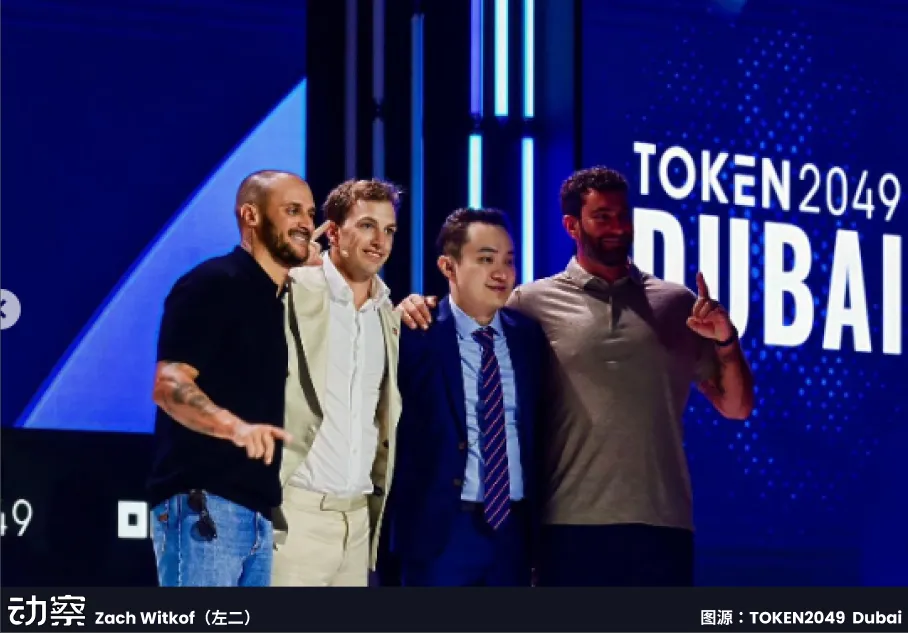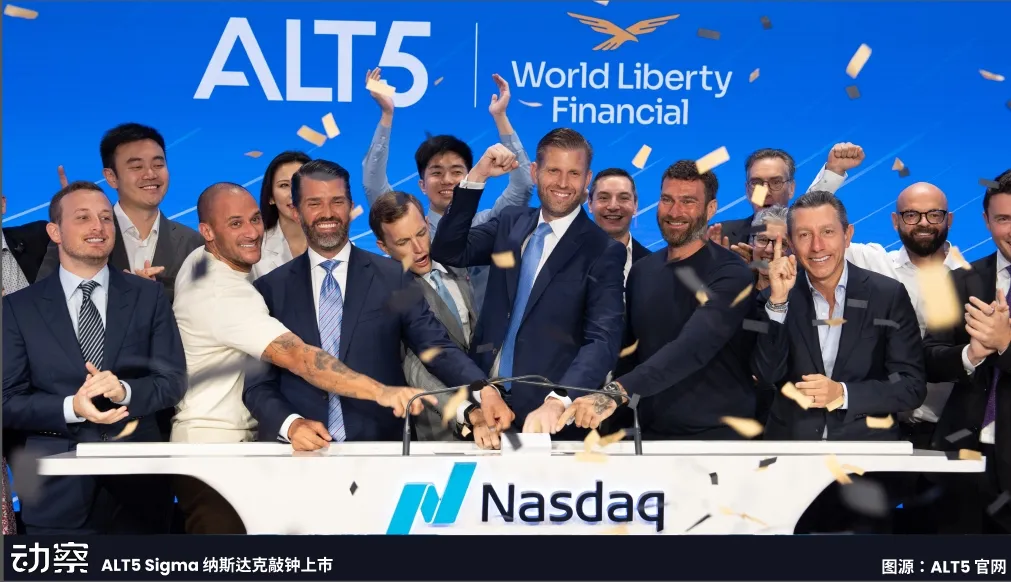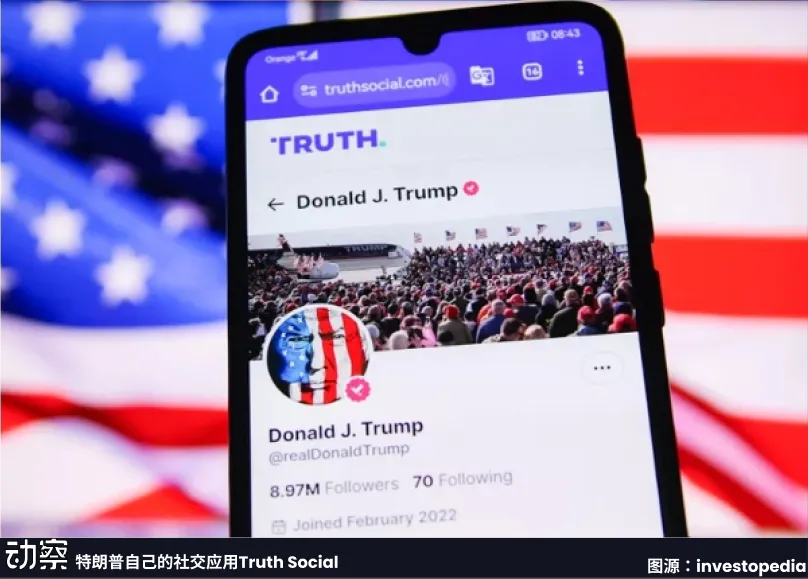Original Author: Lin Wanwan
Original Source: Dongcha
In August, among the pile of announcements on Nasdaq, there was a seemingly ordinary financing deal that exploded like a hidden bomb: ALT 5 Sigma issued up to 200 million shares of common stock at $7.50 per share (approximately 10 billion RMB), exchanging shares for WLFI tokens, and brought Eric Trump, the youngest son of Trump, into the board.
Overnight, this financial technology company ALT 5, which had an annual revenue of only $20 million, transformed into "the Trump family's listed treasury." ALT 5 is not just raising funds; it is brazenly pushing the politically charged WLFI token and its issued stablecoin USD 1 into the U.S. securities system.
WLFI (World Liberty Financial) is not merely a startup; it is a "political mint" crafted by the Trump family.
This company was established two months before the U.S. elections, and within a few months, WLFI has already brought hundreds of millions of dollars in revenue to the family business through the stablecoin USD 1. In other words, ALT 5 is not just integrating a stablecoin, but a complete set of political financial weapons.
The question is—Is ALT 5 really raising funds, or is it selling a wealth ticket inscribed with "political dividends"?
The Secret Lineage of ALT 5: The Interconnection of Three Forces
A company's shareholder list often reveals more than its financial reports.
The shareholder structure of ALT 5 is almost a power puzzle: offshore capital, Wall Street funds, and the political token faction intertwine, making this company appear both as a fintech enterprise and a political financial experiment.
What truly gives ALT 5 a whiff of gunpowder is this type of shareholder: the political token faction. The representatives are two individuals: Zach Witkoff and Eric Trump.
Eric Trump needs no introduction—he is the son of U.S. President Trump, and the family's cryptocurrency industry is currently under his jurisdiction, directly entering the ALT 5 board.
What deserves more attention is Zach Witkoff—co-founder of the WLFI stablecoin and currently serving as the chairman of ALT 5.
If we only look at his resume, Zach Witkoff's background already determines that he will not be an ordinary entrepreneur. He is the son of Steven Witkoff, a prominent real estate developer in New York, who currently serves as the U.S. Special Envoy for Middle East Affairs.
The Witkoff family has decades of accumulation in Manhattan's real estate sector, having held numerous landmark buildings, and his father Steven has had years of dealings with New York's financial and political circles.
The relationship between Zach and the Trump family can be summarized in one sentence: real estate connections + political ties. Therefore, the relationship between Zach and Eric is not just "cooperation," but a familial political financial alliance. 
If Eric Trump puts the family's political resources on the table, then Zach Witkoff is the one executing the financial grounding for the Trump family. He is a key bridge in this intertwining of political and financial interests.
Thus, the existence of these two individuals means that ALT 5's development path will become increasingly politicized. It is not just pursuing commercial expansion but is preparing financial tools for the U.S. political cycle from 2025 to 2028. To some extent, it is part of the Trump family's "financial arsenal."
Next, let's take a look at one of ALT 5's major shareholders, an offshore company registered in the Bahamas—Clover Crest Bahamas Ltd., holding about 11%.
The reason is simple: it can enjoy relaxed tax policies while avoiding excessive regulatory scrutiny. The Bahamas is well-known as a tax haven, where many wealthy individuals and companies register their businesses.
In simpler terms, Clover Crest acts like a hidden channel for the Trump family, allowing money to be quietly funneled into ALT 5 while also isolating risks when necessary.
Another force among the shareholders comes from Wall Street fund companies, such as the well-known Vanguard Group. These types of funds may be indirectly held by retail investors globally, as they manage large-scale index funds.
Vanguard's stake in ALT 5 is not high and appears to be a passive allocation. However, the issue is: when the public sees a name like "Vanguard Group" on the shareholder list, they instinctively perceive the company as "legitimate" and "reliable." This is what is known as legal endorsement.
These three forces each have different logics: offshore financiers provide hidden funding channels to ensure money flows in; Wall Street funds provide facade and legitimacy to ensure the company appears "compliant"; and the political token faction provides narrative and strategic direction, pushing ALT 5 onto the global stablecoin stage.
The combination of these three makes ALT 5 both clean and dangerous.
On the surface, it is a rule-abiding fintech company; in reality, it is being used as a stablecoin version of a "Trojan horse," quietly carrying political and capital ambitions under the guise of compliance.
The FinTech Facade—Where Does the Hidden Door Lead?
On paper, ALT 5 is a perfectly normal fintech company. It holds complete licenses, offering a full suite of services including payment gateways, OTC trading, custody, and white-label exchanges, with an annual revenue of about $20 million and a gross margin close to 50%, making it a top performer in the crypto payment industry. Compliant, transparent, with impressive data, it even appears "cleaner" than many traditional payment companies.
However, what truly propelled ALT 5 from a niche tool-based fintech to a global focus was the $1.5 billion financing in August 2025. Overnight, it was no longer just a company providing APIs but was elevated to a new position—becoming the "Nasdaq treasury" for the Trump stablecoin WLFI.
This means that ALT 5 is no longer just a technology-selling factory but has become a key node in the globalization of stablecoins.
Why is it called a "backdoor"? The reasoning is quite simple.
First is the protection of its surface identity. If the WLFI stablecoin wants to directly enter payment networks in various countries, it will almost certainly hit the high walls of central banks and regulators.
But ALT 5 has existing fintech licenses, allowing it to take the lead as a "payment API service provider." Regulators see a compliant fintech company, not a politically charged stablecoin.
Secondly, there is a hidden channel for cross-border settlement. ALT 5 Pay's API allows merchants to accept cryptocurrencies like BTC and USDT, which can then be automatically converted to USD or EUR in the background.
If WLFI/USD 1 is embedded into this, merchants and users may not even realize they are using a stablecoin backed by the Trump family. On the surface, it is "payment technology," but in reality, it completes the infiltration of stablecoins.
Finally, there is the natural integration with a global network. ALT 5 has already connected the Lightning Network and stablecoin payment systems, which are far more efficient than traditional cross-border payments relying on SWIFT.
For many emerging markets with a strong demand for USD but lacking direct access to Wall Street, ALT 5 provides an invisible express lane. Through it, WLFI can quickly "sink" into global trading scenarios with minimal resistance. 
In this way, the significance of the $1.5 billion financing becomes clear: it is not just simple expansion capital but more like a strategic deployment to lay the groundwork for WLFI's global payment pipeline.
ALT 5 can naturally continue to assure regulators, "We are just a compliant API payment company." But in the shadows, its interfaces may be becoming the tracks for stablecoins to bypass the traditional financial system.
This dual narrative makes ALT 5 a typical "fintech facade." Externally, it appears clean, transparent, and professional, a textbook example of fintech; internally, it is being pushed to a strategic height, becoming an indispensable piece in the puzzle of stablecoin globalization.
This may be the key reason why WLFI can quickly transition from a political concept to a real financial tool: it has found a "legitimate backdoor" like ALT 5.
When the compliant facade is thick enough, stablecoins can quietly flow into merchants' and users' daily transactions, and by the time regulators truly react, that door may have already been wide open.
Trump's Shadow Financial Empire
ALT 5 is just the tip of the iceberg; the larger landscape beneath is the Trump family's effort to create their own dollar system.
They bind politics, media, finance, and mining into one: using voter communities as entry points, turning attention into assets, creating a compliant facade as a channel, and using computing power and Bitcoin reserves as ballast.
On the surface, it involves a few financing deals and new launches, but in essence, it is about rearranging the dollar's pathways: entry, pricing, clearing, and reserves each have corresponding pieces.
The provocation of this landscape lies not in "decentralization," but in the redistribution of power: who defines on-chain dollars, who tells the story of asset prices, who can write it into reports, and who holds the underlying credit. This is not an experiment with a single coin, but a shadow Wall Street that bypasses the traditional one.
From a political perspective, the Trump version of the stablecoin USD 1 represents the financialization of political identity.
In the world of stablecoins, USDT and USDC represent the market and institutions. The former dominates global exchanges with liquidity in gray areas, while the latter wins the favor of mainstream financial institutions relying on compliance and Wall Street credit. However, the positioning of USD 1 is entirely different—it is the stablecoin for Trump supporters.
This is a currency with a distinct political color. Its birth logic is not about "solving payment efficiency" or "reducing cross-border costs," but about binding political identity with financial assets.
For the Trump family, the strategic significance of USD 1 lies in—an all-weather fundraising pool, a tool for community cohesion, and an extension of the dollar narrative. If USDT is the dollar for traders, and USDC is the dollar for Wall Street, then USD 1 is Trump's dollar. It transforms a party's political identity into a circulating financial system.
This design is highly risky and explosive. The risk lies in the fact that once there is a change in political parties or judicial intervention, USD 1 could easily be labeled as an "illegal financial instrument"; the explosive potential lies in the fact that it no longer needs to build a market from scratch; as long as it can engage tens of millions of loyal supporters, it can naturally form a large, cohesive currency community.
From a media perspective, from Truth Social to meme coins, attention is currency.
If USD 1 is the "financial weapon" of the Trump family, then the media is the "powder keg" of this weapon. Without sufficient attention and narrative, even the most perfect stablecoin design can only remain a cold ledger.
The first piece of the family puzzle is Trump Media & Technology Group (TMTG). Its platform, Truth Social, has become a public opinion arena for the right-wing community.
Here, political mobilization and information dissemination are highly homogenized—every opinion and speech from Trump can quickly spread across the platform. 
Another piece of the puzzle is meme coins. The issuance of $TRUMP and $MELANIA coins is an experiment in directly monetizing attention.
This combination of media and finance constructs a closed loop of "narrative—traffic—monetization": political events ignite public opinion → public opinion ferments on Truth Social; meme coins become an outlet for emotions, quickly attracting hot money; TMTG's treasury and stablecoin USD 1 absorb funds, turning short-term emotions into long-term assets.
On the financial side, we have ALT 5, which integrates tokens into U.S. stock reports.
The final piece of the puzzle is mining and Bitcoin reserves.
Supported by the family, American Bitcoin is launching a merger and reverse merger listing route, targeting resources in Asia and North America. In North America, this company primarily holds mining sites and energy bargaining power.
The capital power behind the Trump faction (real estate—energy—finance) is already intricately linked to oil and gas, as well as infrastructure, making it not difficult to acquire BTC mining sites. Thus, controlling the "mining production end" within a coordinated network, they couple "computing power—assets—secondary market."
Therefore, the Trump family's crypto empire is essentially a "power struggle for shadow dollars," and a provocation against the traditional Wall Street financial order.
The political layer provides identity recognition and a funding pool; the media layer generates traffic and cash flow; the financial layer integrates tokens into reports; and the mining layer uses computing power and Bitcoin reserves to place the final stone on this machine.
Epilogue
So the real danger does not lie in USD 1 itself, but in the fact that—the underground copy of the dollar has already begun to operate, and the operators are neither the Federal Reserve nor Goldman Sachs, but the Trump family.
ALT 5 is the entry point, WLFI/USD 1 is the banner, Truth Social and meme coins are the amplifiers, and Bitcoin mining serves as the ballast. On the surface, they seem unrelated; in reality, they are interlocking to form a political financial machine operating in the shadows.
The ambition of this machine is not to create a "compliant version of USDT," but to weld finance and politics together with WLFI, turning payments into votes, making capital flows equivalent to voter flows, and allowing the capital market to directly respond to the electoral battlefield.
If Wall Street is the legitimate palace of the dollar, then the Trump family is quietly constructing a hidden channel, directing the blood of the dollar toward its own parallel empire.
免责声明:本文章仅代表作者个人观点,不代表本平台的立场和观点。本文章仅供信息分享,不构成对任何人的任何投资建议。用户与作者之间的任何争议,与本平台无关。如网页中刊载的文章或图片涉及侵权,请提供相关的权利证明和身份证明发送邮件到support@aicoin.com,本平台相关工作人员将会进行核查。




